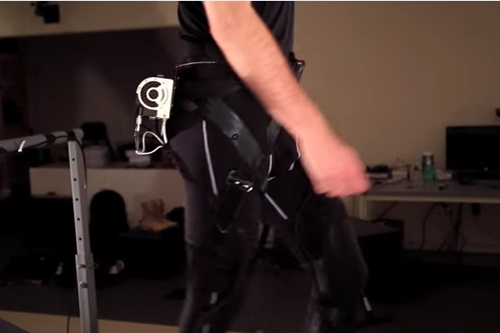17 May 2016. A robotics company is licensing technology from a bioengineering lab at Harvard University to develop systems for people needing help with mobility, such as those with multiple sclerosis or suffering a stroke. Financial aspects of the deal between ReWalk Robotics Ltd. in Yokneam Ilit, Israel and the Wyss Institute for Biologically Inspired Engineering at Harvard were not disclosed.
ReWalk Robotics, founded in 2001, develops robotics systems called exoskeletons, providing support for legs made immobile from conditions such as spinal cord injury. Its latest exoskeleton model, version 6.0, provides motors at the knees and hips, and senses changes in the wearer’s center of gravity to initiate stepping motions. These stepping motions, says the company, simulates the natural gait of a person walking.
The agreement with the Wyss Institute licenses research by engineering professor Conor Walsh, director of Harvard’s Biodesign Lab developing an exosuit, similar in concept to ReWalk’s exoskeleton, but designed for people with limited mobility, including the elderly, and those suffering a stroke or with multiple sclerosis. Soft exosuits take advantage of the wearer’s limited mobility, providing support to joints and muscles, but leaving natural biomechanics unconstrained.
To provide this kind of support for people with limited mobility requires more complex systems with sensors woven into the fabrics and control systems that allow the individual to interact with the robotics. Sensors in the exosuit react not only to movements by the wearer, but also tensions in the fabrics, which act as extensions of the robotic devices. The exosuit blurs the line between apparel and robotics, with its fabrics are worn tightly on the body to provide support and sense all muscular activity in the legs, yet also designed to be comfortable.
The exosuit’s actuator and control systems, worn on a belt at the waist, also need more sophistication. The exosuit needs to detect and anticipate the intent of the wearer to provide added mobility to the limbs at the right time and with the amount of force required. At the same time, muscle movements not needing an assist remain unconstrained.
“ReWalk brings commercialization expertise and experience in the area of wearable robotics and complements our translation-focused research,” says Walsh in a joint statement. “Ultimately this agreement paves the way for this technology to make its way to patients.”
Under the agreement, ReWalk and Wyss Institute will collaborate on further development of the exosuit into clinical trials, as well as regulatory approvals, with commercialization worldwide expected by 2019. ReWalk and Wyss Institute cite estimates of 3 million people in the U.S. with lower-limb disability from stroke, and 400,000 people with multiple sclerosis.
Walsh and colleagues tell more about the exosuit in the following video.
- Autonomous Robot Shown Better at Soft-Tissue Surgery
- NIH Funding New Robotics for Disabled, Children
- Wearable Personal Instruction System Being Developed
- Robotic Exoskeleton Developed for Upper-Body Rehab
- Robotics Designed for Laundry and Other Uncertain Tasks
* * *


 RSS - Posts
RSS - Posts
[…] ReWalk, Wyss Institute Developing Soft Exoskeleton Robot […]